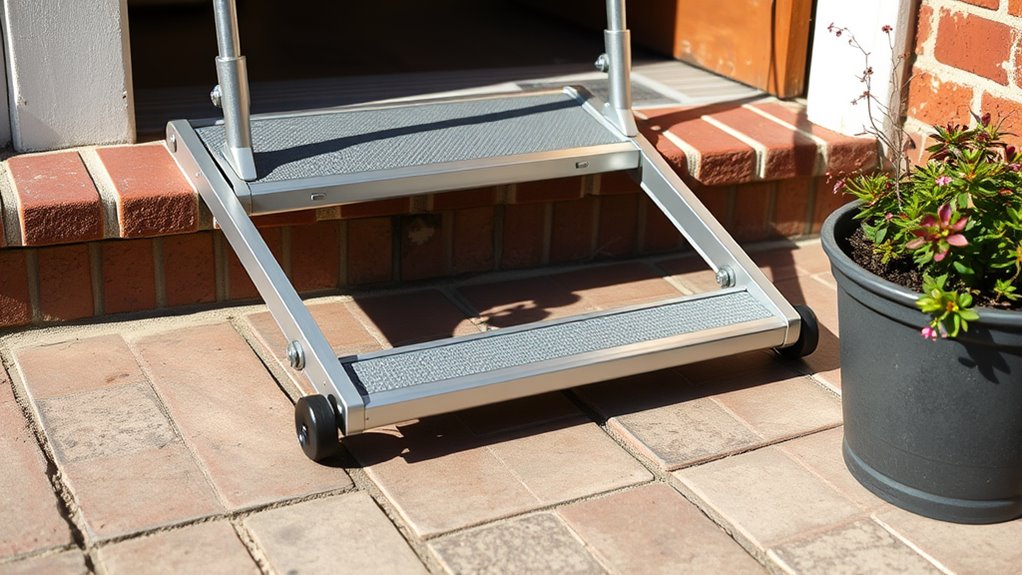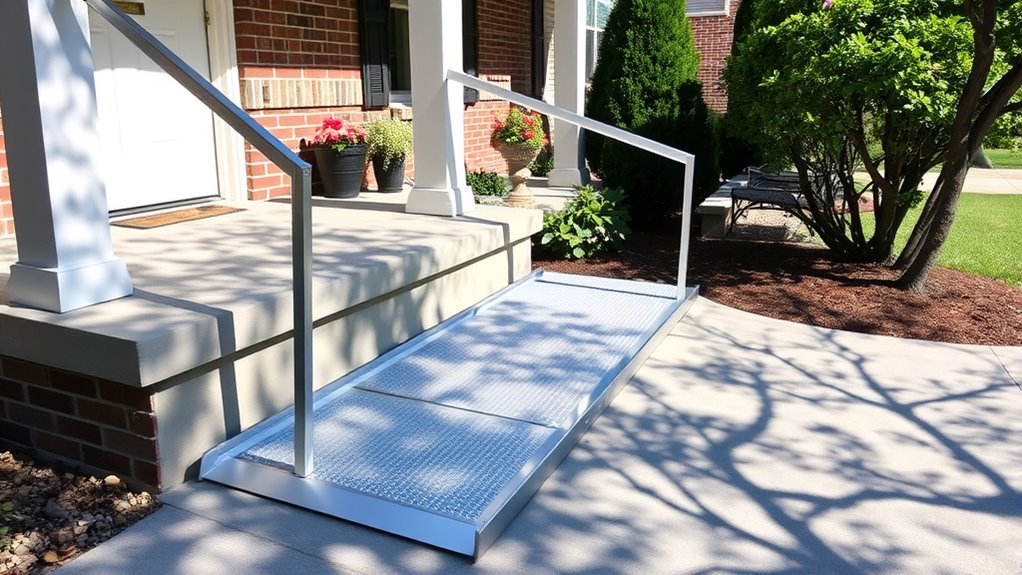Portable ramps are a versatile, affordable way to enhance front porch accessibility, allowing you to move them easily and avoid permanent modifications. They come in various materials and styles to match your home’s look, offering flexibility and temporary solutions for different needs. However, you need enough space for storage and level ground for safe use. If you want to explore how to balance these benefits and challenges, keep exploring more details.
Key Takeaways
- Portable ramps offer flexible, temporary accessibility solutions without permanent modifications.
- They are lightweight and easy to transport, but may require ample storage space when not in use.
- Installation on uneven or unstable surfaces can compromise safety and stability.
- Material choices impact durability, weather resistance, and aesthetic integration with home exteriors.
- Frequent assembly and disassembly can be cumbersome, especially for users with limited strength or mobility.
Advantages of Portable Ramps for Front Porches

Portable ramps offer a practical solution for making front porches more accessible, especially if you need a temporary or flexible option. One major advantage is the variety of material options available, such as aluminum, rubber, and portable wood, allowing you to choose based on durability, weight, and ease of transport. These materials can suit different needs and environments, providing versatility. Aesthetic considerations are also important; portable ramps come in designs and colors that can blend seamlessly with your home’s exterior or stand out if desired. This flexibility helps you maintain curb appeal while ensuring accessibility. Additionally, understanding retirement planning considerations can help you allocate resources effectively for home modifications or accessible solutions. Overall, portable ramps offer a customizable, unobtrusive, and convenient way to improve entryway accessibility without permanent modifications.
Limitations and Challenges of Portable Ramps for Front Porches

While portable ramps offer flexibility, they also come with several limitations that can affect their effectiveness. Storage options can be a concern, especially if space is limited when the ramp isn’t in use. You might find it challenging to store the ramp neatly or securely, which can lead to clutter or damage. Additionally, installation requirements vary; some ramps need a stable, level surface for proper setup, and uneven or soft ground can compromise safety. Portable ramps are typically designed for temporary use, so they may not provide the stability or durability needed for long-term installation. Also, frequent assembly and disassembly can become cumbersome, especially if you’re managing multiple steps or carrying heavy parts. Kia Tuning options for customizing and upgrading your vehicle can influence the choice of ramp, especially if you need to accommodate modifications. These challenges are important to contemplate before choosing a portable ramp for your front porch.
Frequently Asked Questions
How Do I Choose the Right Portable Ramp for My Porch?
When choosing the right portable ramp for your porch, consider how you’ll install it and its material. Look for ramps with clear installation tips, ensuring easy setup without damage. Compare materials like aluminum for lightweight portability or steel for durability. Think about your specific needs, including weight capacity and space constraints. This way, you’ll select a ramp that’s safe, sturdy, and suits your porch’s layout perfectly.
Are Portable Ramps Suitable for All Types of Front Porches?
Portable ramps work well for many front porches, but their suitability depends on your porch’s material options and installation complexity. If your porch is made of concrete or wood, you’ll find some ramps easier to install than others. You should consider the weight capacity and stability of the ramp for your specific needs. While versatile, they may not be ideal for all porch types, especially those with uneven or highly textured surfaces.
What Maintenance Is Required for Portable Ramps?
Maintaining your portable ramp means mastering some simple steps. Regularly clean it with a damp cloth to remove dirt and debris, ensuring safety and slip-resistance. Check for cracks, rust, or loose components, and tighten or repair as needed. Store tips include keeping your ramp in a dry, cool place to prevent damage and deterioration. Proper maintenance maximizes lifespan, making your portable ramp reliable and ready whenever you need it.
Can Portable Ramps Support Heavy Wheelchairs or Scooters?
You wonder if portable ramps can support heavy wheelchairs or scooters. Generally, they do, thanks to their weight capacity and material durability. Most quality ramps are designed to hold significant weight, often between 600 to 1,000 pounds, depending on the model. Make sure to check the specific weight capacity before use, and choose ramps made from durable materials like aluminum or heavy-duty plastic for better support and longevity.
Are There Any Safety Standards or Regulations for Portable Ramps?
You should know that safety standards and regulations for portable ramps include ADA compliance and safety certification. These guarantee that the ramp meets specific weight capacity, slip resistance, and stability requirements. Always check for ADA compliance and safety certification before purchasing or installing a portable ramp, so you can trust it’s safe and reliable for wheelchair or scooter use. Following these standards helps prevent accidents and ensures accessibility.
Conclusion
Portable ramps can be a helpful bridge to greater accessibility, but they’re not without hurdles. Think of them as a stepping stone—great for short-term use but sometimes shaky over the long haul. Weigh their benefits against limitations, like stability and durability, to find the best fit for your porch. With careful consideration, you’ll navigate your decision smoothly, turning obstacles into stepping stones toward a more accessible home.









